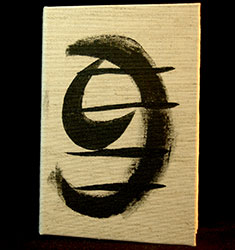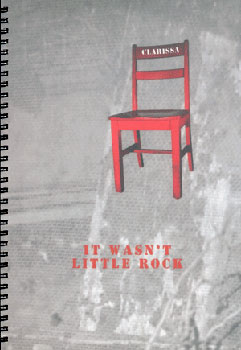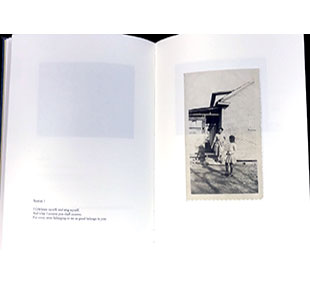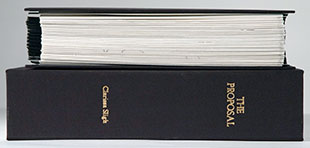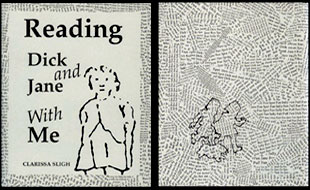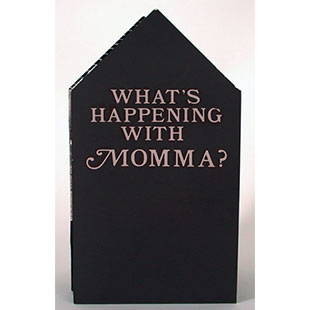
|
|
Share this page: |
| Clarissa Sligh: "Over the past twenty-five years, I have made photographic series, artists' books and text-based installations to explore concepts and constructions of identity, transformation, the family snapshot and the documentary photograph. Project themes vary, but all draw on where I come from: the Southeast, a blue-collar black community, small white frame houses, racially segregated public facilities, the gospel music of summer revivals, rhythm and blues, James Baldwin and jazz. Framing the image is much like choosing a perception on which to base one's reality." | |
| Essay by Carol Lawrence – Clarissa Sligh: Living A Life, the Personal and Political | |
Transforming Hate Review by Robert Bolick "Books on Books Collection – Clarissa Sligh" |
|
Wrongly Bodied: 7.75 x 5"; 160 pages. Printed offset. Perfect bound. Paper illustrated wrappers. Includes essays by Carla Williams, Jake in Transition from Female to Male series, or, Through the Mirror and What Clarissa Found There and Silvia Roncucci, Women in Transition: From Female to Male (translated from Italian). Signed by the author. Clarissa Sligh: "When Deb asked me to photograph her transition from female to male I thought, 'If this chick is a man, then what in the hell am I?' This was 1996 in North Texas. Why would I, a black woman, volunteer to photograph a person who wanted to become a straight white man? |
|
Voyage(r): A Tourist Map to Japan 5 x 7.25"; 144 pages. Printed offset in duotones on Mohawk Options paper. Smythe sewn. Illustrated paper wraps. Signed by author. Prospectus: "In this diary-like artist's book, Sligh recounts a trip to Japan through a thoughtfully constructed montage of photography, texts, and abstract gestural paintings. In personal and poetic musings, the author ponders her relationship to Japanese culture, both as a first time visitor and as an African American woman." Clarissa Sligh: "This work comes out of a visit with people and places in Japan. It is also based on research of the historical circumstances surrounding the United States decision to drop the Atomic Bomb on Japan and reflections on what visiting Hiroshima meant to me as an American." |
|
| Clarissa Sligh Out of Print Title: | |
| Broken By Clarissa Sligh Asheville, North Carolina: Clarissa Sligh, 2014. Edition of 10. 4.5 x 6.25"; 23 pages. Flutter book. Letterpress. Linoleums cuts. Bound in cloth boards. Signed and numbered by the artist. Clarissa Sligh: "I call this my mother book. When I look back at what she was able to do and be with the limitations of her life, I continue to be amazed and my respect for her grows. "As a captive spectator of the relationship between her and my father, I saw him as smart, dashing and witty, appearing strong and overbearing, while she was quiet and demure. He always had the last word but I was always aware that she guided the ship the way she wanted it to go. And I am grateful for that." Clarissa Sleigh, about the making of the book: "This little book came out of an intensive workshop that I took with John Horn (Shooting Star Press), a retired master printer from Little Rock….I signed up for and took his workshop at Penland in 2014. I wanted to see what it was like to be around a master printer at work. … It was truly amazing. "I had a few days to come up with this narrative, set the type, and cut the linoleum blocks. Although I proofed the text numerous times, it wasn't until after the run was fully printed that I saw that the word "her" had been left out. … "After I returned home, I knew the title did not work for the piece, but I put a book together and sent it to John for his archives. That book has a black cloth cover. "I saw that the piece was fatally flawed. Prints didn't always fall in the right place for the folding, a variety of papers were used, the missing word was written in, the title didn't make sense, and the folded pages skewed. I could not fix it but I was hoping the little book might be what someone needed." (SOLD) |
|
It Wasn't Little Rock 8 x 11"; 74 pages. Printed on an Indigo Digital Press. Spiral bound in laminated covers. Prospectus: "The Supreme Court's historic ruling, in the 1954 case of Brown vs. Board of Education, that state-sanctioned segregation of public schools by race was unconstitutional, provided a judicial framework for school desegregation that was tested community by community – often school by school. It Wasn't Little Rock is a telling of stories about Ethel Mozelle Thompson, the daughter of a sharecropper from North Carolina, who entered her children, including Clarissa Sligh, in school desegregation lawsuits that placed them in white schools. But the story line doesn't end there. It is written in the voices of those children, a grandchild, and great-grandchild. Family snapshots, news clippings, letters, and excerpts from legal documents and interviews are intertwined in a personal story of struggle, anger, pride – and the revelation of a family tragedy that led Ethel, a quiet, reserved, 'colored' woman to her activism." Clarissa Sligh: "In this book, the artist sought to understand what motivated her mother, a quiet, reserved, seemingly passive but determined 'colored' woman who grew up in the South, to offer up her children as plaintiffs in the Arlington school class action suits. It is a personal struggle, anger, pride and the revelation of a family tragedy that led Ethel to her activism." |
|
My Mother, Walt Whitman and Me 11 x 8"; 32 pages. Photographs and text printed with archival pigment inkjet onto Arches 90 lb hot press paper. Canson Mi-Tientes 98 lb. paper for end sheets. Cochin and Avenir fonts. Excerpts from Whitman's "Song of Myself" 1940 edition of "Leaves of Grass". Bound by Laura Ladendorf as a cased-in flat back with Japanese and Italian Cialux cloth-covered boards. Signed and numbered by the artist. Clarissa Sligh: "My Mother, Walt Whitman and Me was created for an exhibition curated by Deirdre Lawrence for the 200th anniversary of Walt Whitman’s birthday. I almost did not make this book because of revelations that recent research made known about Whitman’s racism. But one of my friends, Anne Giraud, encouraged me not to walk away because so many artists, including Ralph Ellison, Allen Ginsberg, and Langston Hughes, were influenced by his work. While holding Leaves of Grass in my hands, I realized that I had come face to face with Whitman’s poems as a young person in a very personal way. My Mother, Walt Whitman and Me is an exploration of that recollection. My photographs are simple expressions of the light and the outdoors that are now part of my life. The snapshot of me and my mother was taken by my father 70 years ago." |
|
| A Proposal By Clarissa Sligh Asheville, North Carolina: Clarissa Sligh, 2012. One-of-a-Kind. 10 x 6"; 58 pages. Accordion fold. Cloth covered boards. Signed and dated by the artist. Laid in clamshell box with titles stamped on spine. Clarissa Sligh: "This visual narrative was created to give a sense of what it was like for me, as an African American artist, to make art from white supremacist hate material. It explores my process of turning the repulsive material into an inspirational object. While reflecting on that experience, I began to notice that my writings juxtaposed what I read in the hate literature with events I had witnessed in America from the 1940s through the 1970s. There have been many technological advances, but how much we have progressed as human beings?" (SOLD) |
|
Reading Dick and Jane with Me 7 x 8.375"; 24 unnumbered pages. Offset photo-lithograph. Pamphlet stitched. Signed by Sligh. Clarissa Sligh: "Reading Dick & Jane with Me (1989) is an artist's book created to interrupt the authority of old elementary school textbooks called The Dick and Jane Readers. These reading textbooks of the 1940's and 50's represented a white upper middle class suburban family as normal life for most Americans. Although statistically the average American at this time was working class, the artist as a young girl thought these depictions meant that her family must be an aberration outside the norm. In Reading Dick and Jane with Me, children from Clarissa's old neighborhood stand in for the young people who could never talk back at that time." Sligh underscores the covert, powerful, and potentially dangerous messages sent to young readers when the power of literature, even of the most elemental sort, is backed by the authority (both on a real and spiritual level) of the school. What happens when the young don't see themselves or their worlds reflected in the models foisted upon them? The simplicity of this book's format doesn't conceal the complexity of the issue or the peril of the possible consequences. |
|
What's Happening with Momma? 6.25 x 11.5 x 2" closed; extends to 38". Multiple accordion structure: a larger horizontal structure of 6 panels and 6 vertical accordions affixed to the horizontal panels of 8 panels each. Silkscreen and letterpress. Housed in a clear plastic box. This dimensional, house-shaped book literally unfolds to tell an autobiographical story full of pain and confusion from the author's childhood. Clarissa Sligh, Making Artist's Books (2002): "The emergence of a memory of a younger sister being born at home set into motion the making of What's Happening With Momma? It seemed like a simple idea, but while building and combining text with photographs, I found myself groping for the physical form it would take. "Making book dummies led me to realize that the container had to be a small safe space. But my biggest challenge was to create a structure that would also provide a way for the viewer to interact with the book in order to 'read' it. How could I evoke with photographs, mark making and text something of the way that the Baptist preacher and the gospel and rhythm and blues singers and musicians used repetitive, rhythmic fragments to elicit the audience response necessary for the satisfactory completion of their work? Here too 'the reader' needed to interact with the art. "After agonizing over it for months, I visited Keith Smith's home in Rochester, New York. There I saw a videotaping of a book artist, Susan Share, perform her book in order for it to be seen by the viewer. I knew immediately that her process of 'unfolding' was exactly what my piece was about. That night, a multiple accordion structure came to me in a dream. Waking up, I drew it in my sketchbook on the table beside my bed. The next morning I saw that it was the solution to the problem for which I had been searching. "Initially the book was made using a Van Dyke Brown alternative photographic process. Negatives were pieced together and contact printed for the house-shaped accordion structure. The interior accordion pieces, printed separately on a different paper, were cut, folded and adhered to the interior of the house structure with adhesive. Using these methods, I was able to make a very small and ephemeral edition. The following year, Women's Studio Workshop in Rosendale, New York, awarded me an artist residency fellowship. While there I made a different version of What's Happening With Momma? Ann Kalmbach guided me in strengthening the structure and in printing an edition of 150 books with silk screen inks and letterpress." |
|
Page last update:10.09.2023
Home | About Us | Contact Us | New Arrivals | Fine Press & Artists' Books | Broadsides |Resource Books | Order/Inquiry
Copyright © 2021 Vamp & Tramp, Booksellers, LLC. All rights reserved.
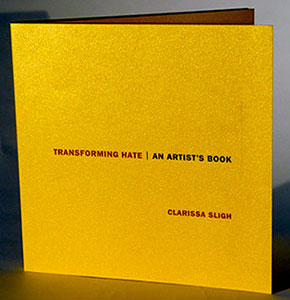
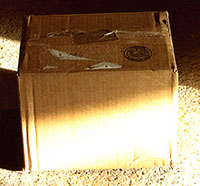
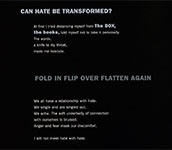
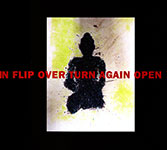
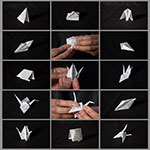
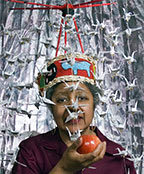
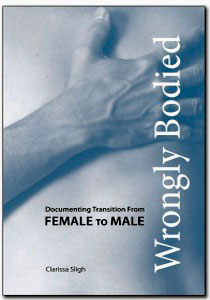
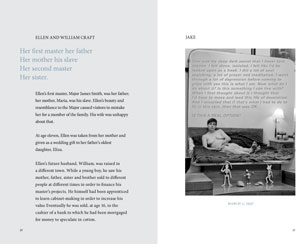
-s1.jpg)
